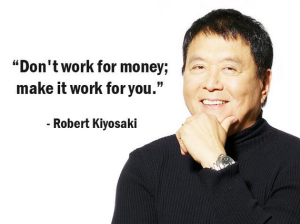Aunty is so thrilled to have one of Kung Fu Girl’s awesome posts here. Aunty “met” her while cruising on the internet looking for real & good financial advice and wisdom, and I now consider her a dear friend, sight unseen as yet. Please welcome and enjoy my new young friend with one of her latest posts, and get a taste of her delightful expertise and spot on analysis. Take it away, KFG!
Here at Kung Fu Finance I endeavor to expose the truth of how wealth-building really works (and how falling prey to hype such as “buy this ONE stock and make 300% in 6 months!” really doesn’t work).
Today is one such occasion, and I would like to expose a dirty little secret of wealth-building…
A few weeks ago I talked about the #1 predictor to your future wealth (your wealth chest or net investible income, commonly referred to as your “savings”) and I specifically discussed why I dislike the word “savings” so much when it’s used to describe that magic and important number — because it focuses on only half of the equation:
What you produce – what you consume = Savings “your wealth chest”
or
Earning – Spending = Savings “your wealth chest”
Now don’t get me wrong—saving is an important part of building wealth. If you spend away every cent you earn, you will quickly find yourself flat broke, or worse, deep in debt (believe me, I’ve been there!).
Learning to “save”, therefore (which really means “not spend”) is a crucial part of basic money management— many famous Hollywood stars have earned millions upon millions of dollars but have still declared bankruptcy because they couldn’t master that skill and instead spent every cent they took in:
Ergo, saving (“the art of not spending”) is very important.
And a million and one websites and resources attempt to show you “how to save”, or more accurately “how to not spend too much money” on the things and experiences you desire (believe me, I’ve perused them all in my pre-accredited-investor life…but more on that in a moment!).
These range from coupon sites to wholesale-membership-type companies like Costco or Sam’s Club to daily deal websites or “Groupons”…there are sites for specific types of people who want to get the best deal on “stuff” (FrugalMom, FrugalDad, MoneySavingMama, etc…) and sites that profess to get you the best deal on money (“zero interest for 6 months!”).
And yes, this “not spending” (e.g. being frugal and “saving”) is vitally important in learning to build wealth and grow your wealth chest.
But, if you look at the inputs to the equation, you can see that spending (or its inverse, “not spending”, so commonly referred to as “saving”) is only half of the equation…it’s only one of the inputs:
Earning – Spending = “your wealth chest”
And this is my beef with calling the net result “savings”, because by calling that magic number “savings”, as is so commonly done around the world, we neglect the other equally important half of the input to the equation:
What you produce (Your “Earnings”)
And I think you’ll agree with me that earning is a pretty important piece of the puzzle!
In fact, it is one of the ways I was able to go from being $10,000 in debt to a bonafide “accredited investor” in under ten years. (I know, it’s not 6 months like the sexy-yet-hype-y hot stock tip I mentioned earlier, but it’s real, and will work for you if you let it!).
This is one of the dirty little secrets of the wealth-building industry (and sadly it’s just one…there are many other dirty little secrets, too): if your spending remains constant, then the more you earn, the more potential you have to build your wealth.
(Duh. It sounds so obvious, right?)
But before you click to close this email and unsubscribe thinking, “I KNEW it! Kung Fu Girl just made millions of dollars per year at some job or business to get out of debt and become wealthy and I’ll never be able to do that!” please hear me out…
That is not the case at all and in fact for several of those years I earned just barely above the poverty line—Kung Fu Guy and I started a business in 2000 called “IdeaWave Systems” and our JOINT revenue our first year was a whopping $50,000 ($25,000 each).
(Now, depending on where you live, this may sound like a decent amount of money…but I assure you, in San Francisco it was NOT. It was barely above the poverty line, which was $27,682 for a single person in 2009 according to the Center for Community Economic Development).
We struggled that first year. (And the next).
We were MASTER cheapskates and could have written the book on “not spending” (saving)—rinsing out plastic baggies and reusing them so we didn’t have to buy more, clipping coupons and eating primarily vegetarian as our grocery budget didn’t allow for steak or salmon or chicken (heck, we barely ate hamburger!), and oh yes, we lived in the ghetto—on 8th and Minna St. affectionately known as “SOMA” (South of Market) which at the time was NOT trendy and cool, not even “up and coming”…just slummy.
We were awakened nightly by riotous street people fighting over abandoned shopping carts and neighbors screaming out of their windows, “Shut up down there!” and the street people shouting back, “No YOU shut up!”. We slept with earplugs and wondered why our parents never came to visit.
We got an A+ in “not spending” that first year…but at most a D- in earning (and that’s being generous). We had so many new skills to learn—as first-time business owners and former engineers we knew how to “do” the work (luckily quite well), but had no idea how to “get” the work.
Marketing? Sales? Not a clue…
It took three long years of consistent execution and under-promising / over-delivering until we built up enough word-of-mouth recommendations to overcome our abysmal lack of marketing and sales expertise, allowing us to finally surpass our pre-business income. Whew.
Though those years were difficult, they were an amazing learning experience.
For in those years, we learned the essence of earning, that crucial second half of the magical wealth equation that is so overlooked by most of society (and all of Wall St.):
Earning = Creating Value for Other People
Because if you hold your spending constant (say you’ve already cut it to the bone and are rinsing out ZipLoc baggies like yours truly…) then the only way to increase your magic number, your wealth chest, is to earn more money.
And the more money you can put into your wealth chest, the more money you will have to invest. It’s that simple (but again, not easy by any means!).
So how on earth do you do that?
This is one of those things that is simple in principle, but extremely difficult in practice…(otherwise we would all be making millions of dollars per year!).
We learned quickly in our business…we earned more money by solving more and more customers’ problems. The more problems we solved, the more value we created for our customers. And the more value we created, the more they paid us.
This is the only true way to earn more money—to create value for other people.
To be clear, customers didn’t care if we made our solutions “fancy” or used the latest slick new programming language or structure to complete their project.
They had one care and one care only—did it solve their problem (for the agreed-upon price that we quoted them)? If it did, and we finished it on time, we had happy customers who were then more than happy to hire us again and tell all of their friends and contacts how wonderful we were, thus giving us that elusive word of mouth marketing.
This is true whether you have a job or a business. In your job, you are working to solve your employer’s problems, and in your business, you are working to solve your customers’ problems.
I wish there was more ink (news, media, etc.) devoted to “how to earn more money” and “how to solve problems” (entrepreneurialism) than there is devoted to “how not to spend money” and “how to be frugal”. While both are important, your earning potential is UNLIMITED, while your “not spending” potential is limited by your basic necessities of life. You have much more opportunity to earn more money than you do to “not spend” money, and yet most people spend hours upon hours clipping coupons and perusing daily deal sites instead of brainstorming how to earn more money and solve people’s problems.
So there you have it…just one more dirty little secret of wealth building!
I encourage you to spend some time this week thinking about how you can earn more money to add to your growing wealth chest! You have so much unique value to share with the world (and be rewarded for!).
To your financial success,
— Kung Fu Girl
Aunty’s note: Wasn’t that awesome! Kung Fu Girl has the gift of breaking down complex financial jargon into stuff even a cave aunty can understand!



 It was a really good day today. Oceanic Cable sent over a nice young man to change out our ancient cable box. It took 3 people to change one little box because of the way I had built in the tv gizmos and closed them into the rehabbed cabinet, but now the end result is clean glass shelves, a new cable box, and a clearer picture!
It was a really good day today. Oceanic Cable sent over a nice young man to change out our ancient cable box. It took 3 people to change one little box because of the way I had built in the tv gizmos and closed them into the rehabbed cabinet, but now the end result is clean glass shelves, a new cable box, and a clearer picture!